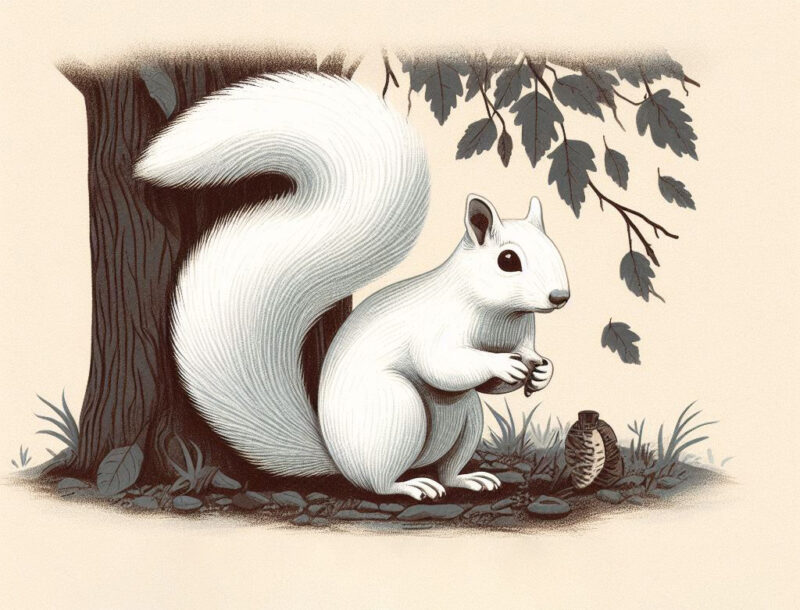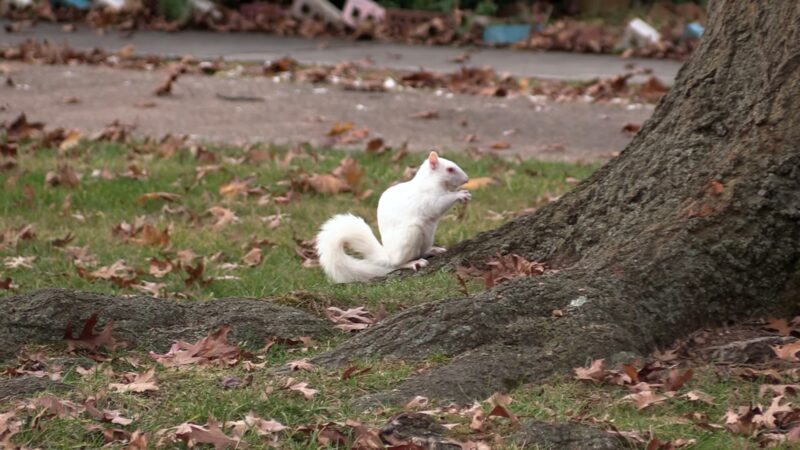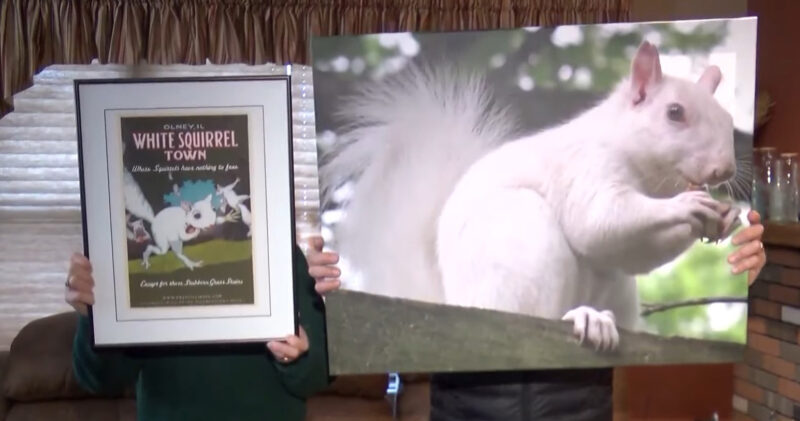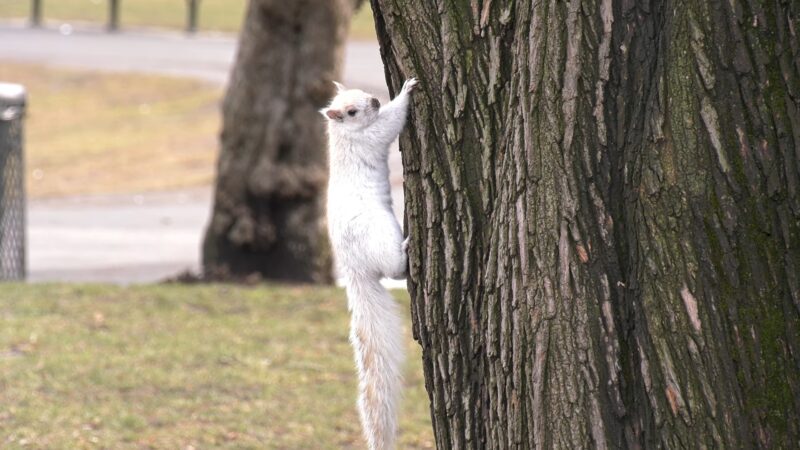White squirrels have long captured the imagination of nature enthusiasts and urban dwellers alike. Their ethereal appearance, contrasting starkly against the green of the trees and the brown of their more common counterparts, makes them a sight to behold.
But what do we really know about these enigmatic creatures? This article delves deep into the world of white squirrels, shedding light on their origins, habits, and the myths surrounding them.
White squirrels are not just a rare sight; they are a testament to nature’s ability to surprise and enchant us. Their pristine fur and captivating presence have made them a subject of intrigue for many.
The primary reason behind their unique coloration is a genetic mutation. This mutation affects the production of melanin, the pigment responsible for the coloration in animals. But there’s more to the story than just genetics.
The Science Behind the Color
Every creature’s coloration has a reason, be it camouflage, attracting mates, or signaling danger. So, what’s the science behind the white squirrel’s unique hue?
There are two primary reasons for a squirrel to be white: albinism and leucism. Albinism is a complete lack of pigmentation, leading to white fur and red eyes.
Leucism, on the other hand, is a partial loss of pigmentation, resulting in white fur but with normal eye color. While the white coloration might seem like a disadvantage in the wild, these squirrels have managed to survive and even thrive in certain areas.
Their rarity might even play in their favor, making them less recognizable to predators.
Habitats and Distribution: Where Can You Spot Them?

If you’ve ever been lucky enough to spot a white squirrel, you might wonder if they have specific habitats or if they’re spread out randomly. Many urban legends surround the habitats of white squirrels.
Some believe they’re omens, while others think they inhabit only sacred groves. In reality, white squirrels can be found both in urban areas and deep forests, depending on the region and the specific genetic mutation they carry.
White squirrels are not limited to one continent or region. From the parks of London to the forests of North America, these creatures have made their presence known.
However, their distribution is patchy, with certain areas having higher concentrations due to genetic factors.
The Famous White Squirrel Colonies
Certain places around the world have become famous for their white squirrel populations, attracting tourists and researchers alike. This park is home to a thriving population of white squirrels.
Locals consider them a town treasure, and they’ve become a symbol of the community. Brevard hosts an annual White Squirrel Festival, celebrating their unique residents. The town even has a dedicated team for white squirrel conservation, ensuring their continued presence.
Myths and Legends: The Folklore of White Squirrels

Every mysterious creature has its share of myths, and white squirrels are no exception. Their rare appearance has given rise to numerous stories and legends.
In various cultures, white animals are considered messengers from the divine or the spirit world. White squirrels, with their ethereal appearance, are often seen as omens or bearers of messages from the beyond.
Some indigenous tribes believe that white squirrels are guardians of sacred groves and that harming them would bring misfortune. This reverence has, in many cases, protected these squirrels from harm.
Debunking the Myths
While myths add to the allure of white squirrels, it’s essential to separate fact from fiction for a true understanding.
Contrary to popular belief, not all cultures see white squirrels as positive omens. In some folklore, their appearance is a warning of impending doom or change.
At the end of the day, white squirrels are just like any other squirrel, albeit with a unique coloration. Their behavior, habits, and needs are similar to their brown or gray counterparts.
It’s essential to treat them with the same respect and care as any other wild animal.
Behavior and Lifestyle: Are They Any Different?
The ethereal appearance of white squirrels often leads people to wonder if their behavior is as unique as their coloration. Do they have different habits, or are they just like any other squirrel?
White squirrels, much like their colored counterparts, are diurnal creatures. They are most active during the early morning and late afternoon, foraging for food, playing, and maintaining their nests.
While their color might set them apart, white squirrels are as social as any other squirrel. They communicate using a series of chirps, tail flicks, and body postures and often engage in playful chases and mock fights.
Diet and Predation

The world isn’t always kind to creatures that stand out. How does the white squirrel’s diet differ, and are they more susceptible to predators?
White squirrels have a similar diet to other tree squirrels. They feed on:
- Nuts (especially acorns and walnuts)
- Seeds
- Fruits
- Occasionally, insects and small birds
Their white fur might make them more visible to predators like hawks, snowy owls, and foxes. However, in areas where they’ve thrived for generations, it’s evident that they’ve developed strategies to evade these threats effectively.
Conservation and Protection: Safeguarding Our White Wonders

With their unique appearance and the myths surrounding them, white squirrels have garnered attention from conservationists and nature enthusiasts alike. But what efforts are in place to protect them?
Like many wild creatures, white squirrels face threats from habitat destruction, pollution, and road accidents. Their distinct coloration can also make them a target for poachers.
Several towns and cities with significant white squirrel populations have put measures in place to protect them. These include designated conservation areas, awareness campaigns, and even festivals to celebrate and educate the public about these unique creatures.
The Role of Communities and Individuals

Communities play a crucial role in the conservation of white squirrels. But what can individuals do to contribute?
Residents in areas with white squirrel populations can make their yards and gardens more squirrel-friendly by planting native trees and providing safe feeding stations.
Spreading the word about the importance of conserving white squirrels and debunking myths can go a long way. Schools, community centers, and local organizations can host talks, workshops, and events centered around these mysterious visitors.
In Popular Culture: The White Squirrel’s Claim to Fame
Beyond myths and legends, white squirrels have found their way into popular culture, becoming symbols of uniqueness and wonder.
Several institutions and organizations have adopted the white squirrel as their mascot, symbolizing rarity, uniqueness, and a touch of magic.
From children’s books to paintings, the white squirrel has inspired countless artists and writers. Their ethereal beauty and the mysteries surrounding them make for compelling narratives and visuals.
Merchandise and Souvenirs

The allure of white squirrels isn’t limited to sightings and stories. Many towns with significant white squirrel populations have capitalized on their unique residents.
White squirrel merchandise is a hit among tourists and locals alike. These items not only serve as souvenirs but also help raise funds for conservation efforts.
Events like the White Squirrel Festival in Brevard offer a plethora of themed merchandise, from handmade crafts to exclusive artworks, allowing enthusiasts to take a piece of the magic home.
FAQ
1. Are white squirrels a separate species?
No, white squirrels are not a separate species. Their unique coloration is due to genetic mutations, either albinism or leucism.
2. Can white squirrels mate with regular squirrels?
Yes, white squirrels can mate with regular squirrels. They belong to the same species and can produce offspring.
3. How long do white squirrels live?
White squirrels have a similar lifespan to other tree squirrels, typically living up to 6-12 years in the wild, depending on environmental factors and predation.
4. Are white squirrels more prone to diseases?
There’s no evidence to suggest that white squirrels are more susceptible to diseases than their colored counterparts.
5. Can I keep a white squirrel as a pet?
It’s essential to check local regulations and laws. In many places, it’s illegal to keep wild animals, including squirrels, as pets. Moreover, wild animals have specific needs that can be challenging to meet in captivity.
Final Words
The world of white squirrels is as enchanting as it is mysterious. These ethereal creatures, with their pristine fur and captivating presence, serve as a testament to nature’s wonders.
As we’ve journeyed through their habitats, myths, and significance in popular culture, it’s evident that there’s more to these squirrels than meets the eye. Their existence reminds us of the importance of conservation, understanding, and appreciation of the natural world.
Let’s continue to be enchanted by them and ensure that future generations also get to experience the magic of the white squirrel.
